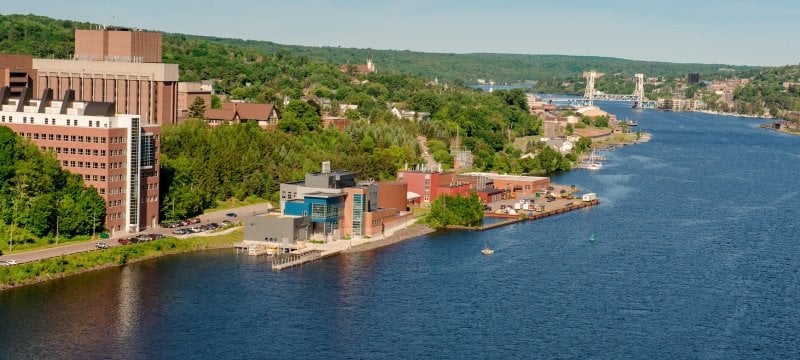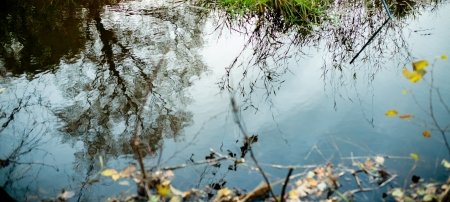When the virus that causes COVID-19 finds its way into wastewater, what happens to it? Environmental engineers will track the coronavirus in wastewater and biosolids to find out.
Unlike many viruses, SARS-CoV-2, which causes the disease COVID-19, is not eliminated in the human gastrointestinal tract. So, when a person infected with the virus — whether they have noticeable symptoms or not — has a bowel movement, the live virus in their feces enters the wastewater stream.
Researchers at Michigan Technological University want to track the fate of SARS-CoV-2 based on past work monitoring and treating other viruses, bacteria and parasitic worms in the solids produced during wastewater treatment.
Beyond COVID-19
As important as it is to treat wastewater for viruses like SARS-CoV-2, there are other ongoing wastewater concerns that deserve increased attention. Removing parasitic worms from wastewater would improve the lives of more than a billion people around the world. Read more on mtu.edu/unscripted.
“We’re not just interested in seeing if the virus is in the wastewater — it undoubtedly will be. We want to know what happens to the virus in wastewater and biosolids,” said Jennifer Becker, associate professor of civil and environmental engineering.
Biosolids are produced during wastewater treatment and then further processed to greatly reduce the numbers of any disease-causing organisms they might contain. After this process, biosolids are often spread on land to improve soil quality and plant growth. The current production methods are very effective at reducing even the hardiest disease-causing organisms historically found in wastewater. However, the SARS-CoV-2 virus clearly doesn't always behave in expected ways.
“We want to make sure the SARS-CoV-2 virus particles are no longer infectious when we spread biosolids,” Becker said. “If any of the virus particles stay in the wastewater stream during treatment, what happens when wastewater is discharged to the environment? We know almost nothing about the answer to this question right now.”

Becker works with Eric Seagren, professor of civil and environmental engineering, Ebenezer Tumban, associate professor of biological sciences, and Daisuke Minakata, associate professor of civil and environmental engineering. The team received seed funding from Michigan Tech's College of Engineering to put together a research proposal to track SARS-CoV-2 in wastewater in partnership with local wastewater treatment facilities, including the Portage Lake Water & Sewer Authority in Houghton.
The tests used to look for the virus in wastewater samples are similar to clinical tests used on people. A positive wastewater test could be used by municipal wastewater managers as an early monitoring tool in communities that have not yet seen other evidence of the virus.
“People can be asymptomatic but are shedding the virus in their stool,” Becker said. “Dr. Seagren and I have for several years been doing research looking at the fate of pathogens in wastewater treatment biosolids.”
Becker believes the research team will find coronavirus particles in the biosolids, but that the virus will be inactivated and unable to cause disease a relatively short time after being spread in the environment. To test this theory, the research team has proposed spiking biosolids with another virus that shares many properties with SARS-CoV-2, but does not cause serious illness in humans. By exposing the biosolids to different combinations of temperature, sunlight and moisture, and by measuring the levels of this other virus in the biosolids over time, the researchers should be able to predict the survival of the coronavirus under a wide range of conditions.
Next Steps
Although EPA standards for wastewater and biosolids treatment are rigorous and the measures for managing biosolids land application are protective of human health, the Michigan Tech research team does not want to take it for granted that conventional wastewater treatment systems are removing SARS-CoV-2.
About the Researcher
“We want to verify that the human coronavirus is being adequately inactivated,” Becker said. She also observed that previous work with Seagren, which involved spiking biosolids with a human poliovirus strain that is used in live vaccines and thus does not cause polio illness, showed that human poliovirus goes away much more quickly than other pathogens found in, or spiked into, biosolids, especially the eggs of parasitic worms.
“We have a lot of experience with monitoring pathogens in wastewater and wastewater solids,” Becker said. “We look forward to applying this experience to monitoring for human coronavirus to aid wastewater managers and use wastewater treatment plants as a COVID-19 surveillance tool.”
Since the Michigan Tech researchers proposed their research plan, scientists at Michigan State University and other research institutions have begun discussing the development of a network of labs that could monitor for the virus throughout Michigan. A lab in the Upper Peninsula at Michigan Tech would be especially helpful for detecting the virus in UP communities. Currently, the Michigan Tech researchers are seeking additional funding sources and developing strict safety procedures.
“We all think of food and water as being essential to life. They are, but waste is also a critical part of life,” Becker said. “All organisms generate it, and it’s something people don’t really want to deal with. However, we all produce waste, and we have to manage it appropriately to protect public health and the quality of our environment. This is one of the key responsibilities of environmental engineers, and it’s really essential to sustaining livable communities.”
Michigan Technological University is an R1 public research university founded in 1885 in Houghton, and is home to nearly 7,500 students from more than 60 countries around the world. Consistently ranked among the best universities in the country for return on investment, Michigan's flagship technological university offers more than 120 undergraduate and graduate degree programs in science and technology, engineering, computing, forestry, business, health professions, humanities, mathematics, social sciences, and the arts. The rural campus is situated just miles from Lake Superior in Michigan's Upper Peninsula, offering year-round opportunities for outdoor adventure.







Comments